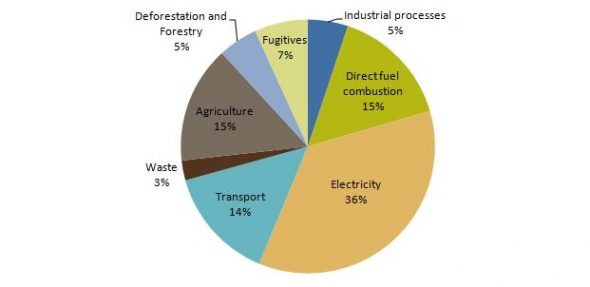Yesterday, during Senate question time and just as the Doha Climate Summit was getting underway, the Australian Government revealed that it will commit to reducing emissions by a minimum of 0.5 per cent below 1990 levels during phase-two of the Kyoto Protocol (“Kyoto 2”). The announcement of this target has again turned the spotlight on the adequacy of Australia’s emission targets.
When news of Australia’s Kyoto 2 target broke in Doha there was some confusion about whether the 99.5% commitment represented a weakening of ambition from the existing pledge to cut emissions by 5 per cent below 2000 levels by 2020. This confusion is due to the particular way emission targets are inscribed in the Kyoto Protocol.
The target inscribed in the Kyoto Protocol applies to an entire eight year period (2013-2020), rather than a just for 2020. It requires Australia to limit its average annual emissions over the next eight years to no more than 99.5 per cent of 1990 emission levels.
As illustrated in the graph below, to come up with its Kyoto 2 target, the government simply drew a straight line from Australia’s first Kyoto target (108 per cent) to where emissions need to be in order to achieve the 5 per cent 2020 pledge. The mid-point along this line is 99.5 per cent.
Put simply, while it may sound weaker, a 99.5 per cent Kyoto 2 target is consistent with Australia’s existing pledge to reduce emissions by at least 5 per cent below 2000 levels by 2020.

The significance of the Kyoto 2 target is that it is used to calculate Australia’s legally binding carbon pollution budget for the next eight years – the maximum volume of greenhouse gas Australia is allowed to release into the atmosphere between now and 2020. If Australia exceeds this carbon budget it will need to rely on carbon permits from overseas, or risk being penalised.
Adopting a carbon budget is important because it is the cumulative build-up of greenhouse gases in the atmosphere over a period of time that drives global warming, not emissions from any one year. In other words if we want to limit global warming we really need to focus on constraining the cumulative carbon budget, rather than focusing exclusively on single year targets.
So how does Australia’s Kyoto 2 target shape up? The simple answer to this question is ‘not very well’, if we want to avoid 2 degree warming. However, the door is not shut on moving to a stronger target in the coming years.
Since 2009 the Government has said the 5 per cent target represents a minimum level of ambition for Australia, which is not dependent on commitments from other countries. Alongside this unconditional target, the Government has said it is willing to move either a 15 per cent or 25 per cent target depending on the strength of commitments made by other countries. Significantly, given their differences on the carbon price, this target range has bipartisan support.
Back in 2010 it was revealed that the Government’s own analysis shows that the conditions for moving to a target above 5 per cent have already been met. Indeed this view is has been supported by independent analysis suggesting that the conditions for moving to a 15 per cent target are likely to have been met.
WWF and others believe Australia should immediately move to adopt a 25 per cent target as Australia’s minimum contribution to global efforts to avoid dangerous climate change. The Intergovernmental Panel on Climate Change (IPCCC) in 2007 recommended developed countries aim for a 2020 target of between 25-40 per cent. The Australian government itself agrees that reducing emissions by 25 per cent by 2020 would represent Australia’s fair share of the global effort to keep global warming below two degrees Celsius.
The silver-lining in Australia’s Kyoto 2 target is that it will be accompanied by a reference to the full 5-25 per cent target range, along with a statement confirming that Australia remains open to strengthening its target in the coming years. While this in no way binds Australia to moving to the 25 per cent target, it does send a powerful signal to the international community that a stronger target is indeed a credible prospect.
Including a reference to the 5-25 per cent target range in the Kyoto Protocol also ensures that the Climate Change Authority is in no way constrained when making recommendations on the caps for the emissions trading scheme in 2014. This means the ambition spotlight will soon move on from Doha to focus on the Authority’s review process, which kicks off next year.
It’s more critical than ever that the independent Climate Change Authority receives full support from all sides of politics. As a country with a lot to lose if the world doesn’t act to keep global warming below 2 degrees we can’t let the interests of a few override the benefits of strong action for the rest of Australia.
Will McGoldrick is Climate Change Policy Manager at WWF-Australia and is currently attending the Doha Climate Summit







